This post contains affiliate links. Read my disclosure policy here.
This Vegan Thai Green Curry recipe is a fragrant and flavorful one-pan dish that is crammed with wholesome vegetables and tofu simmered in a rich and creamy green sauce! With a mix of mildly spicy, savory, tangy, and umami flavors- this dish will make your senses reel in delight! You can make it in 30 minutes and customize the heck out of it to your liking!
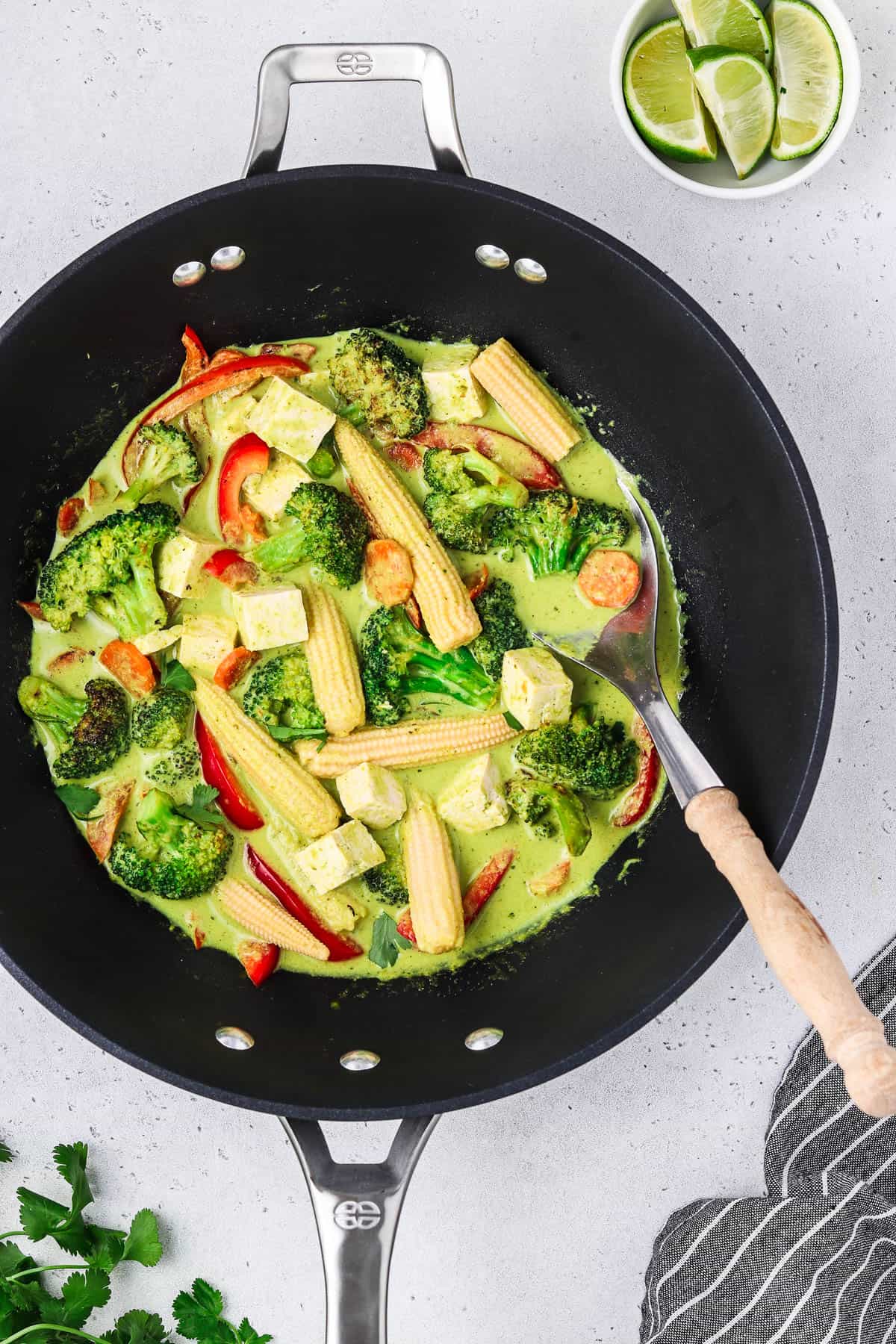
I have cooked a lot of delicious curry recipes and all of them have something that makes them special! Some are mildly spicy like my Tofu Katsu Curry and some have a kick like this Thai Green Curry. One thing that they have in common though is that they are full of flavor!
With this Thai-style dish, I just love how all the complex flavors work so well together.
The spiciness from the serrano pepper is toned down by the sweet and nutty coconut milk, and the freshness of lime juice, basil, and cilantro. While the addition of the miso paste and coconut sugar gives it that subtly-sweet umami flavor!
Vegan Thai Green Curry Ingredients
Don’t be daunted by the number of ingredients needed to make this. Most of them come from the homemade green curry paste, but it's easy to prep and will make everything so rich and flavorful. Here's what you'll need for the paste and some additional notes:
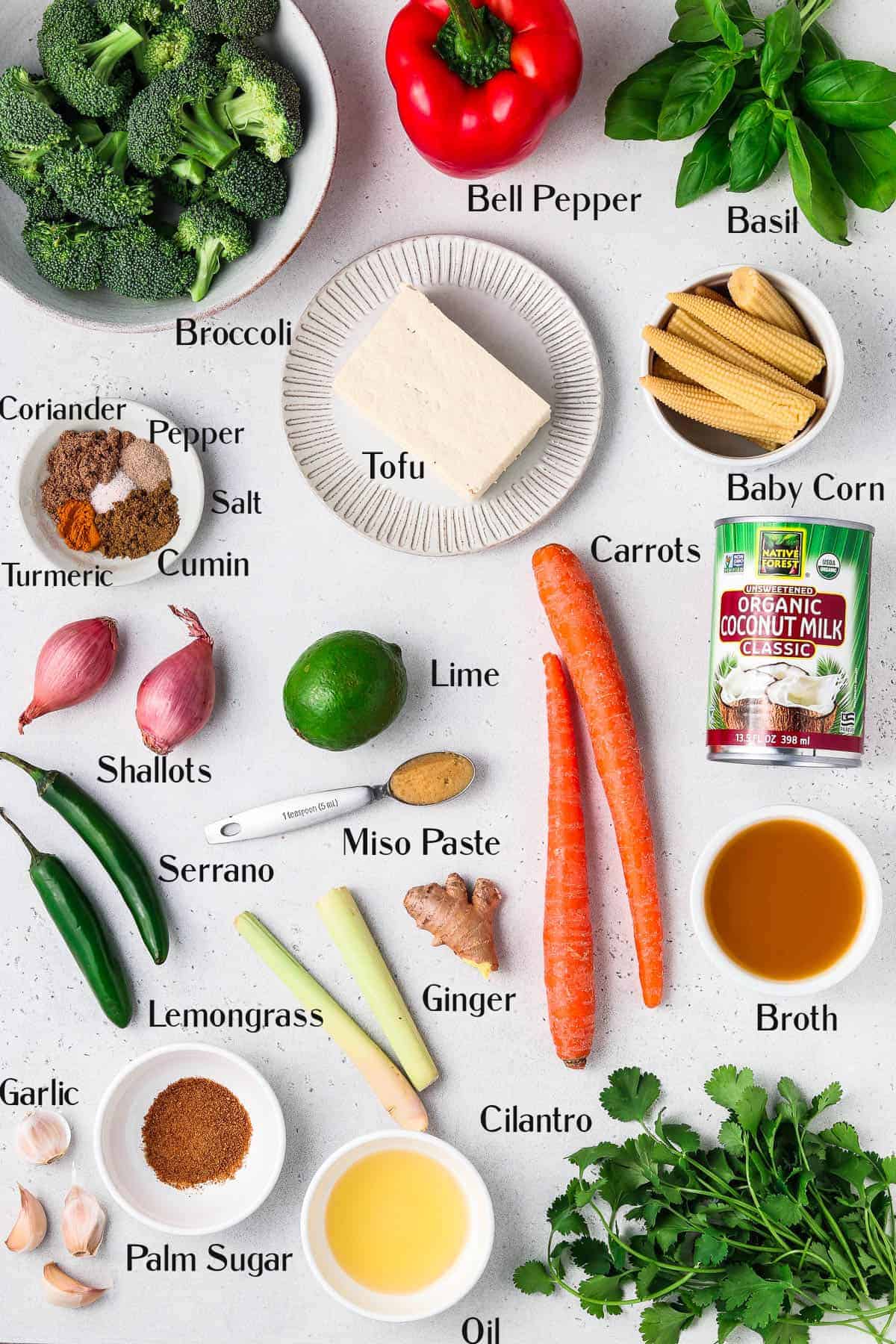
1. Homemade Green Curry Paste
- Serrano peppers – Traditionally, you would use green Thai chili peppers (prik kee noo suan), but they are not readily available at my local grocery store. They are very spicy, so I go with serrano to replace them. If you want less heat, you can choose jalapeño peppers.
- Garlic – I prefer fresh, but store-bought paste will work here too.
- Ginger – fresh is my first choice, but paste will work nicely too.
- Shallots – you can also use half of a small yellow onion.
- Lemongrass – you can usually find this in most grocery stores in the produce section. I haven't found a replacement for it. I noticed a paste in the grocery store but it contained milk.
- Ground cumin, coriander, and turmeric – I highly recommend the cumin, but you can skip coriander and turmeric if you don't have them.
- Lime – kaffir lime would be ideal, but I haven't found them in my local grocery store, so I use regular lime. If you don't have lime, you can use lemon, but I would zest only half the lemon and use 1 tablespoon of lemon juice. You can always add more later on.
- Basil – Use Thai basil if you can find it. Otherwise, regular basil works beautifully.
- Cilantro – I don't have a replacement to recommend, but if you absolutely hate cilantro, you can try adding extra basil and a small amount of fresh parsley. The flavor will be different but still delicious.
- White pepper – adds a sharper bite, but black pepper is just as good. Fresh-cracked is best!
- Miso paste – yellow or white will work well and will add a mild umami flavor. If you don't have it, you can add a few dashes of tamari when the broth and coconut milk are added. Also, if you can't have soy, you can use chickpea miso paste.
2. The remaining ingredients
This Thai Green Curry is very versatile so feel free to use whatever veggies you have in your fridge. Just remember to keep the ratios as equal as you can. Also, some veggies take longer to cook, so make sure to cut them into smallish pieces and add them first. Here's what you'll need:
- Avocado oil – any cooking oil will do. Coconut oil is my second choice for this recipe.
- Red bell pepper – green or yellow bell pepper will work.
- Broccoli – cauliflower is a great alternative.
- Carrots – parsnips or daikon are just as tasty.
- Baby corn – it adds a nice crunch and subtle sweetness. Water chestnuts would be a nice substitute.
- Vegetable broth – you can use water, but I prefer the extra flavor from the broth.
- Coconut sugar – you can also use agave, maple syrup, or brown sugar.
- Full-fat coconut milk – if you don't have it you can use a non-dairy heavy cream that is unsweetened. You can also use lite coconut milk but the sauce will be much thinner.
- Extra-firm tofu – need a soy-free protein source? Chickpeas work perfectly!
How to prep
This won't take too long and it's really all the work you'll have to do. The cooking process is a breeze and it'll come together quickly. Feel free to buy pre-cut veggies to make it even easier.
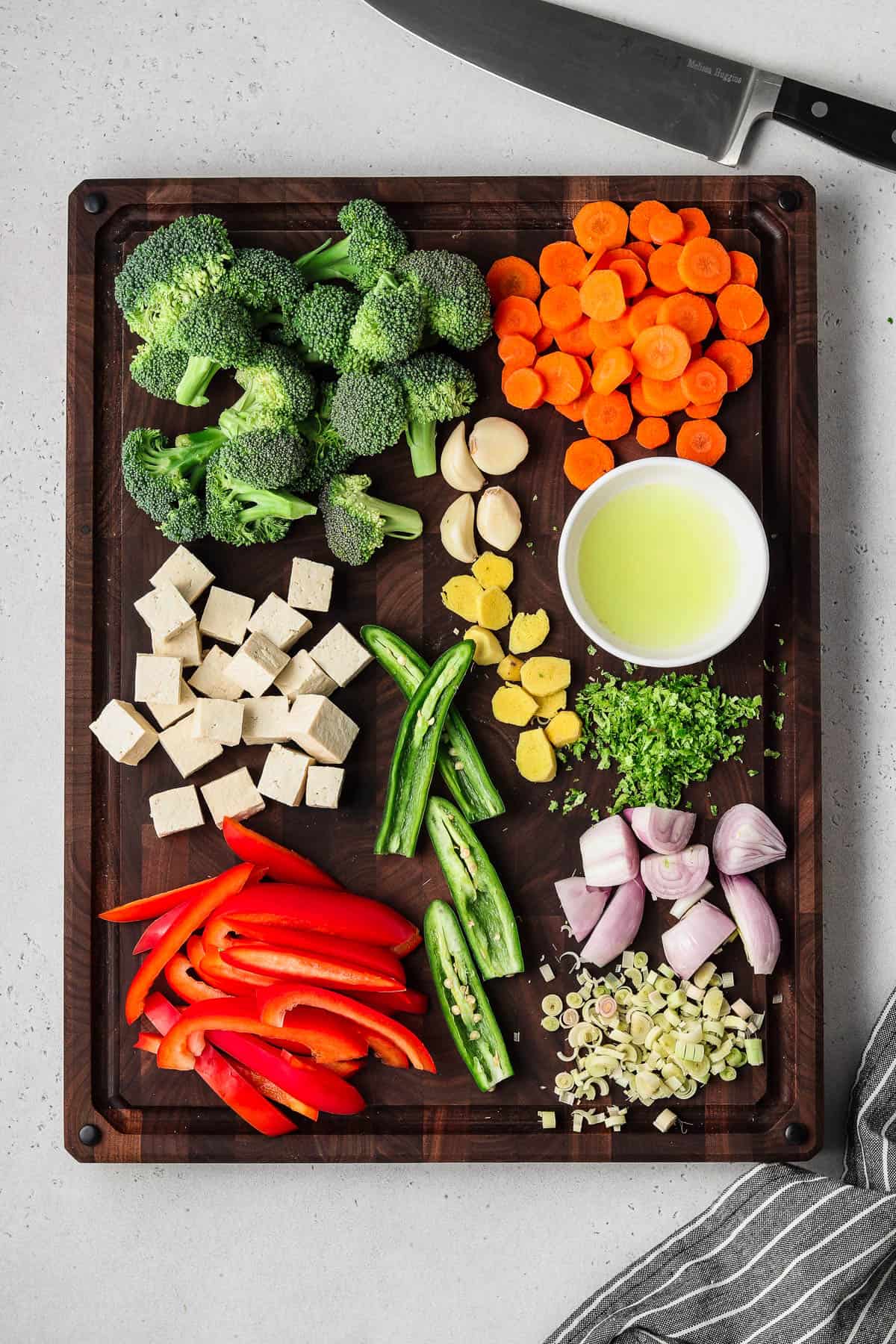
Prep for the paste
- Peel the garlic cloves or buy pre-peeled ones.
- Finely chop or thinly slice the lemongrass. It has a few tough outer layers that need to be peeled off before use. You'll notice it'll be much easier to cut once you hit the tender portion. It has a whitish or light green color. Here's a quick tutorial on how to cut lemongrass.
- Peel and slice the ginger
- For the serrano peppers, remove the stems and some seeds to reduce heat.
- Zest and juice the lime. Make sure to zest it first!
- Quarter the shallots
Prep for the rest
- Cut the broccoli into bite-sized florets or buy pre-cut florets
- Peel and slice the carrots. You can dice them too
- Deseed and slice the bell pepper
- Cut the tofu into cubes
How to make Vegan Thai Green Curry
Once you have prepped the ingredients, it goes pretty quickly, so have everything right near your cooking station. Here's a step-by-step visual of what you'll need to do:
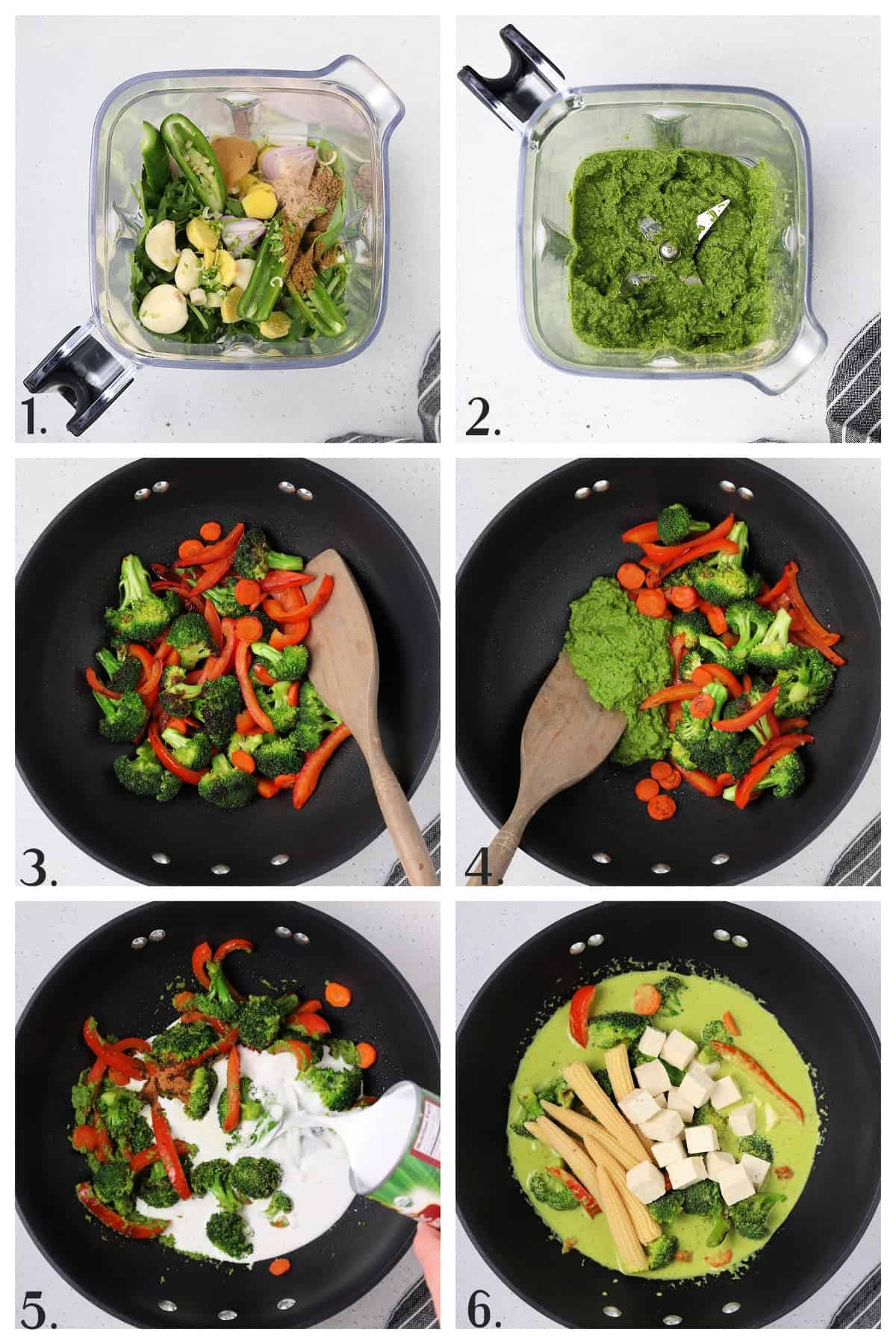
- Place the paste ingredients into a high-powered blender with a narrow pitcher.
- Pulse on high 5-6 times to get everything going, then blend on high until it breaks down and starts to form a paste. Use the blender tamper as needed.
- Heat oil over medium heat. Add the broccoli, red bell pepper, and carrots. Sauté until they are slightly browned and crisp-tender.
- Move the veggies over to the side of the pan and add a drizzle of oil. Add the green curry paste and sauté for 2-3 minutes until it’s fragrant and excess moisture has reduced. Stir into the veggies to combine and sauté for 1 additional minute.
- Add the broth, coconut milk, sugar, salt, and pepper into the pan and stir to combine. Raise the heat to bring to a simmer, then lower the heat to gently simmer.
- Add the tofu cubes and baby corn, then cover the pan. Cook until the sauce thickens and reduces slightly, stirring occasionally. Taste for seasoning and add more if needed.
Tips and Tricks
1. If your blender strains when making the curry paste, add a few splashes of coconut milk, oil, or water to get it going until the lemongrass and ginger break down completely.
2. For a spicier dish, keep the pepper seeds in. If you want just a hint of it, you can remove all the seeds or use jalapeño instead of serrano. Or make it kid-friendly by omitting the chilies altogether.
3. If you have a blender with a wide base, you may have trouble blending the paste. A food processor with a small work bowl will work or you can use a mortar and pestle.
What to serve with Thai Green Curry
For a hearty meal, serve this Vegan Thai Green Curry with freshly cooked white rice and garnish with chopped cilantro, green onions, and a lime wedge. You can also go light and serve it with cauliflower rice, couscous, or quinoa. Whatever you choose to pair it with, it is sure to be delicious!
Make ahead and Storing
If you are planning to add this dish to your regular dinner rotation, you can make a big batch of green paste curry and store it in a tight-lidded jar ready to use any time! It’ll cut down the cooking time even more and you can have this scrumptious dish in a jiffy.
For any leftovers, just place them in an airtight container and refrigerate them. It will keep for 2-4 days.
Is it gluten-free?
All the ingredients used for this Vegan Thai Green Curry are naturally gluten-free! However, some products like tofu may contain gluten during production so always check the package information before using. If subbing the miso paste, use tamari instead of soy sauce.
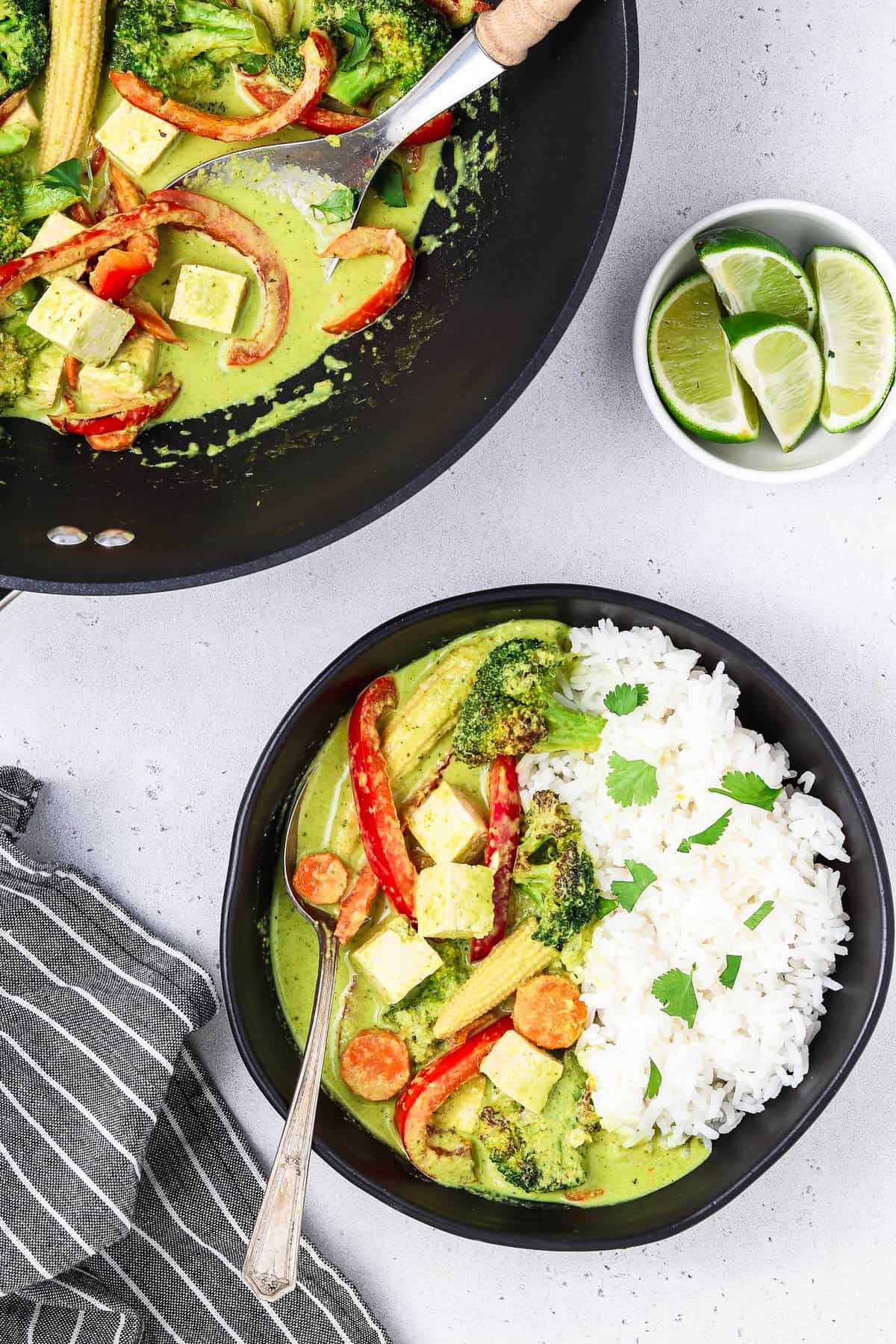
More Curry Recipes to Enjoy
Did you make this recipe? Let me know what you think by leaving a star ⭐️⭐️⭐️⭐️⭐️ rating and sharing your feedback in the comment section below. It would make my day!
⭐️ Subscribe to the Vegan Huggs Newsletter and receive weekly recipes straight to your inbox! You'll also receive my FREE eCookbook featuring my top 10 recipes.
Recipe
Vegan Thai Green Curry
Ingredients
Green Curry Paste
- 2 serrano peppers , remove stems and some seeds to reduce heat.
- 4 cloves garlic , peeled
- 2 medium shallots , peeled and quartered
- 2 stalks lemongrass , trim and peel off tough outer layers. Finely chop the inner tender portion.
- 2-inch knob fresh ginger , peeled & sliced (sub with 2-3 teaspoons jarred, paste, or frozen)
- 1 teaspoon ground cumin
- 1 teaspoon ground coriander
- ¼ teaspoon ground turmeric
- Zest and juice of one lime (*zest lime first)
- ¼ cup fresh basil , tight-packed
- ½ cup fresh cilantro , tight-packed
- ¼ teaspoon ground white pepper (sub with black)
- 1 teaspoon miso paste , yellow or white *optional (add salt to taste if not using)
Curry
- 1.5 tablespoons avocado oil or preferred oil (+ more for drizzling)
- 1 red bell pepper deseeded, veins removed, and sliced
- 1 small head of broccoli cut into bite-sized florets (about 2 heaping cups)
- 2-3 medium carrots , sliced into coins
- 6-8 pieces baby corn , sliced in half lengthwise of left whole
- ½ cup vegetable broth
- 13.5 ounces full-fat coconut milk , canned
- 1-2 teaspoons coconut sugar sub agave, maple syrup, or brown sugar
- 8 ounces extra-firm tofu , gently press out excess water, and cube
- ½ teaspoon salt , more to taste
- Ground pepper , to taste
For Serving (optional)
- Rice (about 3 cups cooked)
- Chopped cilantro
- Lime wedges
Recommended Equipment
- Blender or Food Processor
Instructions
Green Curry Paste
- Place all of the paste ingredients into a high-powered blender with a narrow pitcher. Pulse on high 5-6 times to get everything going. Scrape down the sides as needed. Now, blend on high until it breaks down and starts to form a paste, using the blender tamper as needed. If your blender is straining, you can add a few teaspoons of coconut milk (from the recipe ingredients) or water to help it along. The paste doesn’t have to be completely smooth, just make sure the lemongrass and ginger have broken down well. You can use a food processor as well.
Curry
- In a large pan, heat oil over medium heat. Once heated, add the broccoli, red bell pepper, and carrots. Sauté until they are slightly browned and crisp-tender. About 4-6 minutes. This is just to bring out more flavor, the veggies will cook more in the curry.
- Move the veggies over to the side of the pan and add a drizzle of oil. Once heated, add the green curry paste on top. Sauté for 2-3 minutes until it’s fragrant and excess moisture has reduced. Stir into the veggies to combine and sauté for 1 additional minute.
- Add the broth, coconut milk, sugar, salt, and pepper into the pan and stir to combine. Raise the heat to bring to a simmer, then lower the heat to gently simmer. Add the tofu cubes and baby corn, then cover the pan. Cook until the sauce thickens and veggies are tender, stirring occasionally. About 4-6 minutes. Taste for seasoning and add more if needed. The curry sauce should be on the thin side, but If it’s too thin for your taste, you can let it cook a few minutes longer uncovered. If it’s too thick, you can thin it out with broth or water.
- Serve in a bowl with a side of rice. Garnish with fresh cilantro, green onions, and lime wedges, if preferred.


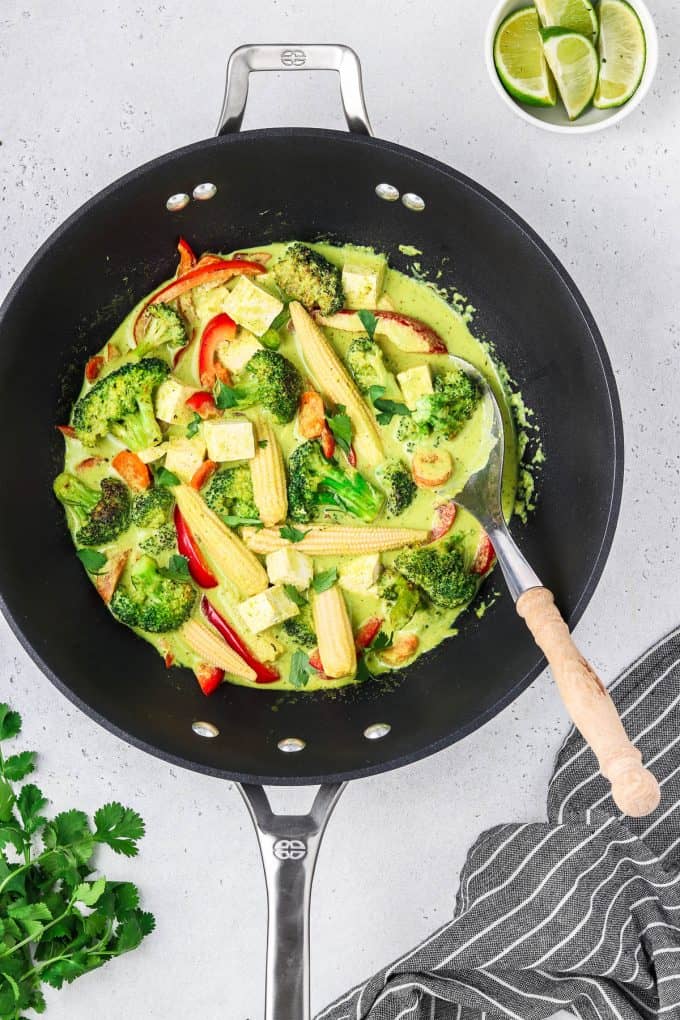
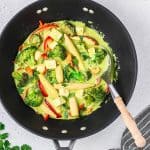
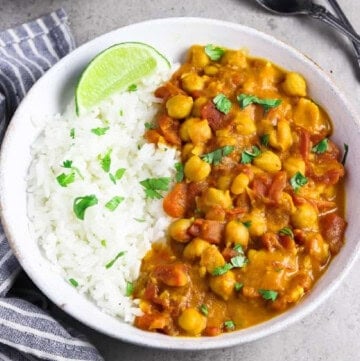
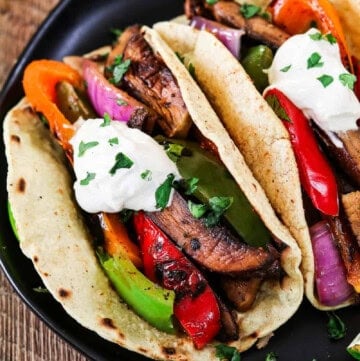
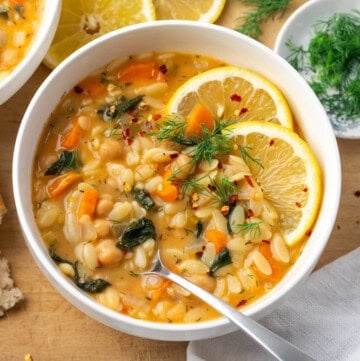
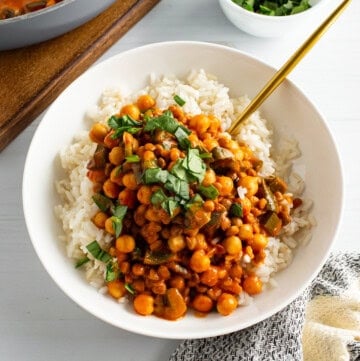

Mandy
I made this for dinner tonight and it was DELISH. I used jalapeños instead of serranos so it wouldn't be too spicy for my kid. It was actually a lot easier to make than I expected, too. Always a plus! This is going to be added to my regular meal rotation.
Melissa Huggins
Hi Mandy, I'm so happy you loved the recipe. Thank you for sharing your wonderful feedback. 🙂
Patricia Eilers
How much paste should I anticipate this making?
Melissa Huggins
Hi Patricia, it's about 3/4 cup. If you use store-bought paste, you will only need 3-6 tablespoons. This will depend on how spicy you want it. 🙂
Sita
Looks delicious and can’t wait to try it. Can something be substituted for the coconut milk and the oil to make it fat free? Thanks, Sita
Melissa Huggins
You can water sauté the veggies instead of using the oil. You can try it with regular unsweetened soy milk, but it won't be as thick and rich. You may have to use a thickener like all-purpose flour or cornstarch as well. I just haven't tested it though. I hope this helps a little. Thanks for stopping by 🙂